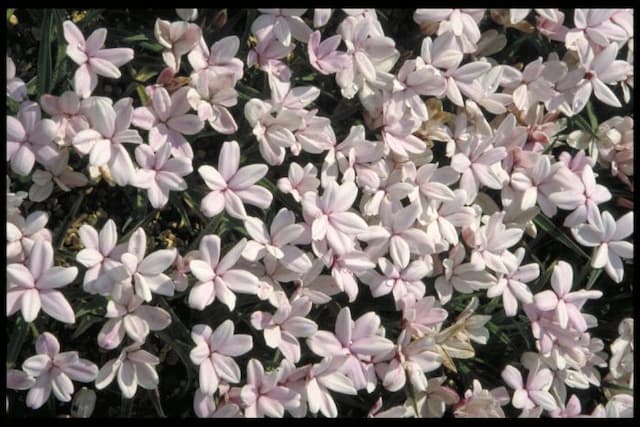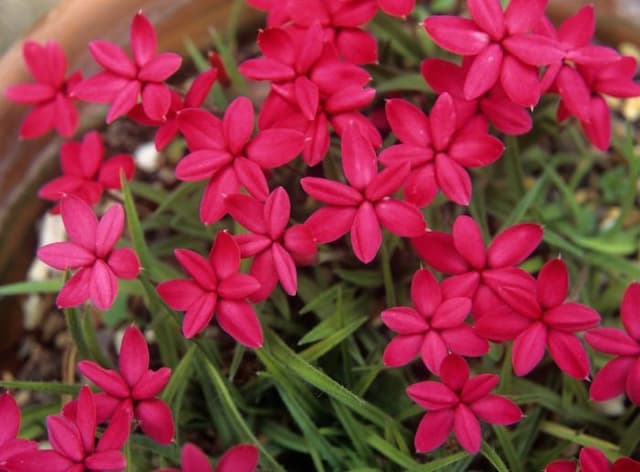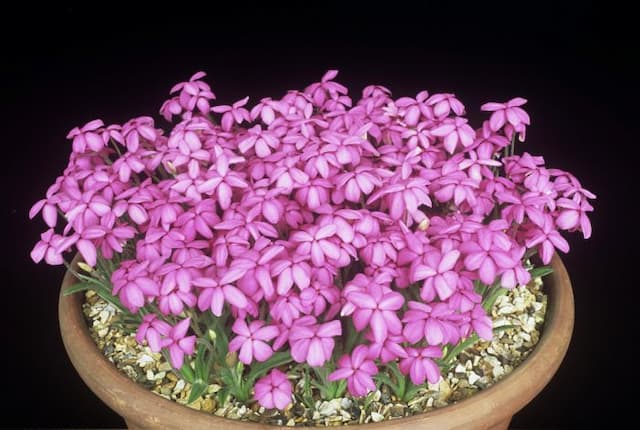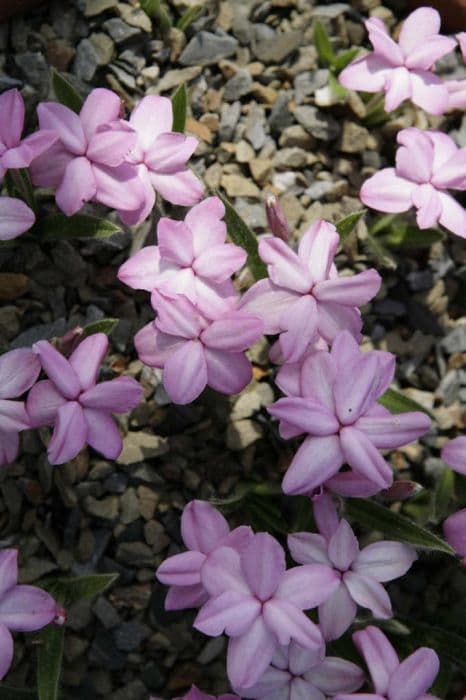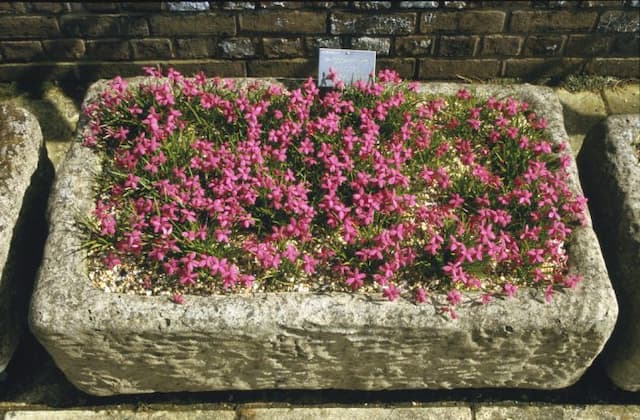Rhodohypoxis Rhodohypoxis 'Candy Stripe'

ABOUT
The plant known as Candy Stripe is a charming perennial that features a notable contrast in coloring. It is distinguished by its vibrant flowers which exhibit a striking striped pattern, generally composed of a blend of pink and white hues that catch the eye. These blooms have a star-like shape, typically with six petals that spread outwards, creating a delightful show in the garden. The plant's foliage forms a lush, compact mat of narrow, grassy leaves that are green in color, serving as an attractive backdrop to the colorful flowers that emerge above them. This foliage provides a dense, textured appearance that adds to the aesthetic appeal of the Candy Stripe. Overall, the plant is prized for its showy, candy-striped flowers and neat, tidy clumps of leaves that bring color and vibrancy to any setting in which they are planted.
About this plant
 Names
NamesFamily
Hypoxidaceae.
Synonyms
Red Star, Rhodohypoxis Baurii "Candy Stripe".
Common names
Rhodohypoxis 'Candy Stripe'.
 Toxicity
ToxicityTo humans
Rhodohypoxis 'Candy Stripe', commonly known as Rhodohypoxis, does not have a well-documented profile regarding toxicity to humans. There is limited information available, and it is generally not known for being a poisonous plant. However, as with any plant, individual sensitivities can vary, and it is always advisable to avoid ingesting plants not known to be safe for consumption. In the absence of specific toxicity data, it is wise to err on the side of caution and prevent any part of the plant from being eaten. If ingestion does occur and any symptoms arise, medical advice should be sought.
To pets
Rhodohypoxis 'Candy Stripe', commonly referred to as Rhodohypoxis, is not generally listed as toxic to pets. While the plant is not considered to be poisonous, the lack of definitive toxicity data means that pet owners should still exercise caution. It is best practice to prevent pets from ingesting this or any plant, as there can be individual cases of adverse reactions or gastrointestinal upset. If a pet does ingest Rhodohypoxis and shows any signs of illness, such as vomiting or diarrhea, a veterinarian should be consulted.
 Characteristics
CharacteristicsLife cycle
Perennials
Foliage type
Deciduous
Color of leaves
Green
Flower color
Pink
Height
6 inches (15 cm)
Spread
6 inches (15 cm)
Plant type
Bulb
Hardiness zones
7
Native area
South Africa
Benefits
 General Benefits
General Benefits- Ornamental Appeal: Adds vibrant color to gardens with its striking pink-striped flowers.
- Compact Size: Ideal for small spaces, rock gardens, and containers due to its dwarf growth habit.
- Low Maintenance: Requires minimal care once established, making it suitable for busy gardeners.
- Drought Tolerance: Can survive periods of low water, reducing the need for frequent irrigation.
- Cold Hardy: Capable of withstanding cooler temperatures, which is beneficial for gardens in temperate zones.
- Attracts Pollinators: Flowers provide nectar for bees and butterflies, supporting local ecosystems.
- Deer Resistant: Less likely to be damaged by deer, making it a good choice for rural gardens.
 Medical Properties
Medical PropertiesThis plant is not used for medical purposes.
 Air-purifying Qualities
Air-purifying QualitiesThis plant is not specifically known for air purifying qualities.
 Other Uses
Other Uses- Rhodohypoxis 'Candy Stripe' can serve as a colorful addition to fairy gardens, where their striped pink flowers add a touch of whimsy and enchantment.
- These plants can be used in photography as a natural backdrop or prop, providing a vivid pop of color to still-life compositions or macro photography subjects.
- They are suitable for use in 'living' art installations, where their distinct striped blooms can be part of a larger tapestry of living plants arranged for aesthetic appeal.
- A ground cover for miniature railroads or other scale model displays, Rhodohypoxis 'Candy Stripe' can give a realistic and vibrant touch to tiny landscapes.
- They can act as a natural dye source; the pigments from the petals may be used in crafting natural dyes for textiles or paper.
- The plant can be used in educational settings, where children or students might observe the growth and blooming cycle as they study botany or ecology.
- Rhodohypoxis 'Candy Stripe' is perfect for container arrangements in small urban spaces or balconies, as it doesn't require much room to provide a burst of color.
- These plants can be a part of a sensory garden, where visitors can touch and see the distinctive textures and colors up close, enhancing their sensory experience.
- Their ability to attract pollinators like bees and butterflies can be utilized in a pollinator-friendly garden setting, supporting local ecosystems.
- In crafting, the blooms can be pressed and used in creating bookmarks, greeting cards, or other paper-based crafts, providing a natural floral embellishment.
Interesting Facts
 Feng Shui
Feng ShuiThe Rhodohypoxis baurii is not used in Feng Shui practice.
 Zodiac Sign Compitability
Zodiac Sign CompitabilityThe Rhodohypoxis baurii is not used in astrology practice.
 Plant Symbolism
Plant Symbolism- Vitality and Energy: The Rhodohypoxis 'Candy Stripe', known commonly as Rhodohypoxis or Red Star, often symbolizes vitality and energy due to its bright and vibrant blooms.
- Hope and Renewal: This plant's ability to bloom in the spring is often seen as a symbol of hope and the renewal that comes with new beginnings.
- Attracting Positivity: The striking pattern of the 'Candy Stripe' may represent the attraction of positive energy and good vibes.
- Charm and Attractiveness: The aesthetic appeal of the Rhodohypoxis can symbolize charm and attractiveness, making it a delightful addition to any garden.
- Adaptability: As a plant that can thrive in various conditions, it is also a symbol of adaptability and resilience in life.
 Water
WaterFor the Rhodohypoxis baurii, commonly known as the Rhodohypoxis or Rosy Posy, it is best to maintain moist soil during the active growing season in spring and summer by watering every few days, depending on weather conditions. An average of 1 inch of water per week is a good reference, but this should be adjusted based on rainfall and temperature, as the plant does not tolerate drought well. Reduce watering in the winter as the plant goes dormant, allowing the soil to dry out slightly between watering sessions. Avoid overwatering, which could lead to root rot, especially in cooler months. If potted indoors, ensure the container has proper drainage to prevent water accumulation.
 Light
LightRhodohypoxis baurii prefers bright, indirect sunlight to partial shade. It thrives best when placed in a spot that receives morning sunlight and is shielded from the intense afternoon sun. Avoid full shade as it may hinder flower production and overall growth. An east- or west-facing window sill or a lightly shaded spot in the garden are ideal locations for the Rosy Posy.
 Temperature
TemperatureRhodohypoxis baurii, or Rosy Posy, flourishes in temperatures ranging from 50°F to 75°F. While it can tolerate temperatures as low as freezing for brief periods, prolonged exposure to temperatures below 32°F could be harmful. During its growth period, maintaining temperatures within the ideal range ensures optimal development. Protect the Rosy Posy from extreme temperatures by providing insulation or moving it indoors if necessary.
 Pruning
PruningPrune the Rosy Posy to remove spent flowers and any damaged or diseased foliage. This will encourage further blooming and maintain a healthy, compact growth habit. Pruning is best done after the main flowering period, usually in late summer, but deadheading during the season is beneficial as well. Regular pruning helps to rejuvenate the plant and keeps it looking its best.
 Cleaning
CleaningAs needed
 Soil
SoilThe best soil mix for Rhodohypoxis baurii 'Candy Stripe', commonly referred to as Red Star, is a well-draining, loamy or sandy composition with added organic matter. Aim for a soil pH slightly acidic to neutral, between 5.5 and 7.0. A mix of two parts peat, one part loam, and one part sand or perlite works well.
 Repotting
RepottingRed Star, or Rhodohypoxis baurii 'Candy Stripe', should be repotted every two to three years. It's best to repot in early spring just as growth resumes, using a well-draining, loamy soil mix to refresh nutrients and encourage new growth.
 Humidity & Misting
Humidity & MistingRhodohypoxis baurii 'Candy Stripe', or Red Star, thrives at moderate to high humidity levels, ideally between 40-60%. These conditions mimic their natural habitat and help maintain healthy, vibrant foliage.
 Suitable locations
Suitable locationsIndoor
Place Red Star in bright, indirect light; keep soil moist in summer.
Outdoor
Plant Red Star in partial shade with well-draining soil; protect from frost.
Hardiness zone
7-9 USDA
 Life cycle
Life cycleThe life of the Red Star plant, commonly known as Rhodohypoxis 'Candy Stripe', begins with seed germination, which takes place in a moist, well-draining soil mix during spring. After germination, the seedlings develop into small, bulb-like corms which produce narrow, grass-like leaves as they mature. During late spring to summer, the plant blossoms, displaying its notable pink-striped white flowers that attract pollinators. Post-flowering, the plant enters a dormancy phase in late summer to autumn when the leaves die back, and the corm conserves energy underground. Throughout the dormant winter period, the corm remains inactive until the following spring when environmental conditions trigger the start of a new growth cycle. With each successive year, the corms may propagate by division, creating a clump of plants that expands progressively.
 Propogation
PropogationPropogation time
Spring-Summer
The most popular method of propagating the Rhodohypoxis 'Candy Stripe', commonly known as the Rosy Posy, typically involves the division of its clumps. This is often done in late winter or early spring, just as the plant begins to emerge from dormancy. To propagate by division, carefully lift the clump from the ground using a spade or garden fork, ensuring to minimize damage to the tubers. Once the clump is out, gently tease apart the individual tubers, ensuring that each section has at least one growing point. These divisions can then be replanted immediately at a depth of about 1 inch (2.54 cm) in well-draining soil, spaced several inches apart. It's important to water the newly planted tubers well to help establish them, but then allow the soil to dry slightly between waterings to prevent rot.
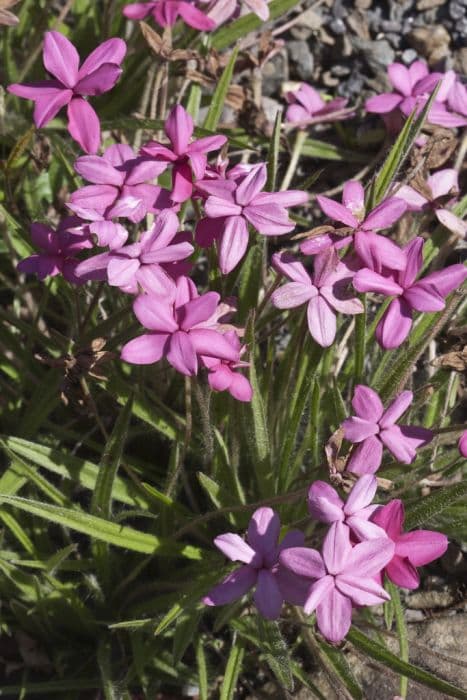
![Rhodoxis [Fairytale]](/_next/image?url=https%3A%2F%2Fplants-admin.emdemapps.com%2Fimages%2Fplants%2F%2Fimages%2F604b54204420d.png&w=640&q=75)

